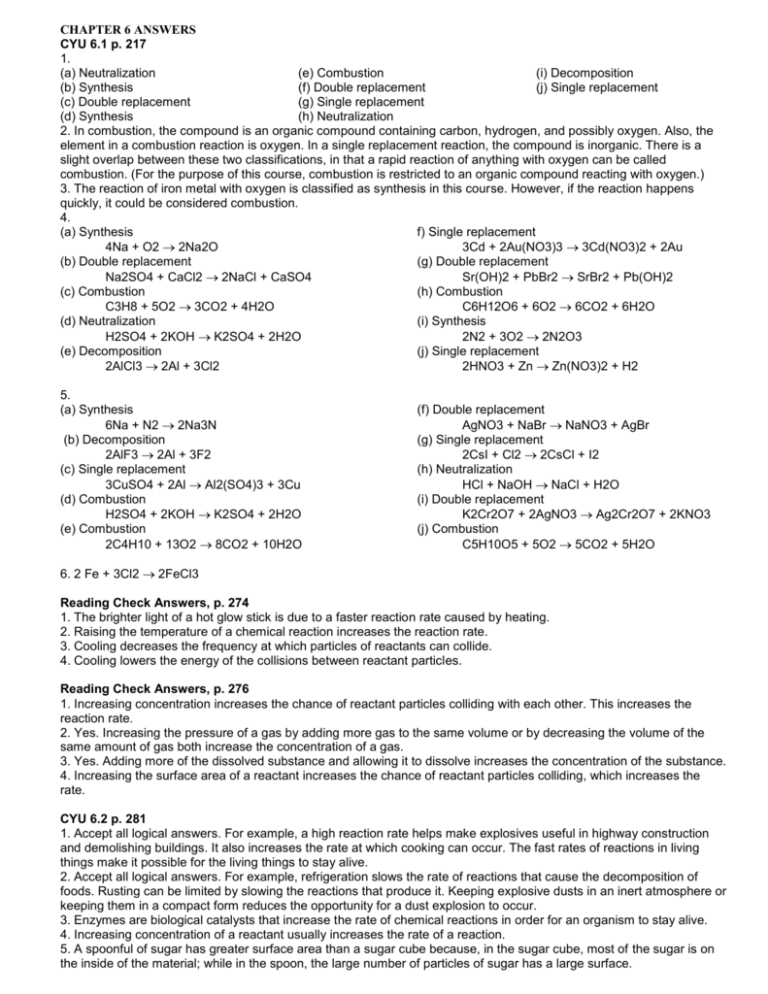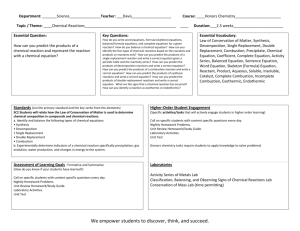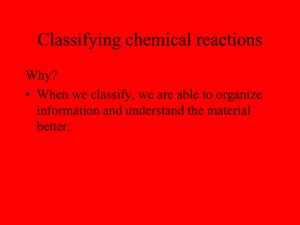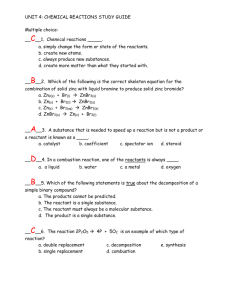File
advertisement

CHAPTER 6 ANSWERS CYU 6.1 p. 217 1. (a) Neutralization (e) Combustion (i) Decomposition (b) Synthesis (f) Double replacement (j) Single replacement (c) Double replacement (g) Single replacement (d) Synthesis (h) Neutralization 2. In combustion, the compound is an organic compound containing carbon, hydrogen, and possibly oxygen. Also, the element in a combustion reaction is oxygen. In a single replacement reaction, the compound is inorganic. There is a slight overlap between these two classifications, in that a rapid reaction of anything with oxygen can be called combustion. (For the purpose of this course, combustion is restricted to an organic compound reacting with oxygen.) 3. The reaction of iron metal with oxygen is classified as synthesis in this course. However, if the reaction happens quickly, it could be considered combustion. 4. (a) Synthesis f) Single replacement 4Na + O2 2Na2O 3Cd + 2Au(NO3)3 3Cd(NO3)2 + 2Au (b) Double replacement (g) Double replacement Na2SO4 + CaCl2 2NaCl + CaSO4 Sr(OH)2 + PbBr2 SrBr2 + Pb(OH)2 (c) Combustion (h) Combustion C3H8 + 5O2 3CO2 + 4H2O C6H12O6 + 6O2 6CO2 + 6H2O (d) Neutralization (i) Synthesis H2SO4 + 2KOH K2SO4 + 2H2O 2N2 + 3O2 2N2O3 (e) Decomposition (j) Single replacement 2AlCl3 2Al + 3Cl2 2HNO3 + Zn Zn(NO3)2 + H2 5. (a) Synthesis 6Na + N2 2Na3N (b) Decomposition 2AlF3 2Al + 3F2 (c) Single replacement 3CuSO4 + 2Al Al2(SO4)3 + 3Cu (d) Combustion H2SO4 + 2KOH K2SO4 + 2H2O (e) Combustion 2C4H10 + 13O2 8CO2 + 10H2O (f) Double replacement AgNO3 + NaBr NaNO3 + AgBr (g) Single replacement 2CsI + Cl2 2CsCl + I2 (h) Neutralization HCl + NaOH NaCl + H2O (i) Double replacement K2Cr2O7 + 2AgNO3 Ag2Cr2O7 + 2KNO3 (j) Combustion C5H10O5 + 5O2 5CO2 + 5H2O 6. 2 Fe + 3Cl2 2FeCl3 Reading Check Answers, p. 274 1. The brighter light of a hot glow stick is due to a faster reaction rate caused by heating. 2. Raising the temperature of a chemical reaction increases the reaction rate. 3. Cooling decreases the frequency at which particles of reactants can collide. 4. Cooling lowers the energy of the collisions between reactant particles. Reading Check Answers, p. 276 1. Increasing concentration increases the chance of reactant particles colliding with each other. This increases the reaction rate. 2. Yes. Increasing the pressure of a gas by adding more gas to the same volume or by decreasing the volume of the same amount of gas both increase the concentration of a gas. 3. Yes. Adding more of the dissolved substance and allowing it to dissolve increases the concentration of the substance. 4. Increasing the surface area of a reactant increases the chance of reactant particles colliding, which increases the rate. CYU 6.2 p. 281 1. Accept all logical answers. For example, a high reaction rate helps make explosives useful in highway construction and demolishing buildings. It also increases the rate at which cooking can occur. The fast rates of reactions in living things make it possible for the living things to stay alive. 2. Accept all logical answers. For example, refrigeration slows the rate of reactions that cause the decomposition of foods. Rusting can be limited by slowing the reactions that produce it. Keeping explosive dusts in an inert atmosphere or keeping them in a compact form reduces the opportunity for a dust explosion to occur. 3. Enzymes are biological catalysts that increase the rate of chemical reactions in order for an organism to stay alive. 4. Increasing concentration of a reactant usually increases the rate of a reaction. 5. A spoonful of sugar has greater surface area than a sugar cube because, in the sugar cube, most of the sugar is on the inside of the material; while in the spoon, the large number of particles of sugar has a large surface. 6. Increasing surface area increases the rate of a reaction. 7. For example, when two gases react, there is no surface between them. Hydrogen and oxygen gases react to produce water, and surface area is not a factor. 8. A catalyst makes it possible for reactions to occur with less energy than reactions that do not have a catalyst. The catalyst helps molecules line up better so that, when they collide with each other, the reaction takes place with less energy than would otherwise be required. 9. (a) Raising the temperature, increasing the concentration (b) Raising the temperature, adding a catalyst (c) Raising the temperature increases the number of collisions and also makes them more effective because the collisions happen with greater energy. 10. Raising the temperature increases the number of collisions and also gives the collisions a greater amount of energy. 11. Increasing the surface area gives greater opportunity for reactant particles to collide. This increases the rate of reaction. 12. Increasing the concentration of a reactant gives a greater opportunity for reactant particles to collide. This increases the rate of a reaction. 13. A catalyst helps reactant molecules to line up more effectively than without a catalyst. This allows the reaction to happen with less energy. CHAPTER 6 REVIEW p. 282 1. (a) Neutralization (b) Synthesis (c) Synthesis (d) Decomposition (e) Neutralization (f) Double replacement (g) Single replacement (h) Single replacement (i) Double replacement (j) Combustion 2. (a) Al + F2 AlF3 (b) K + O2 K2O (c) C2H6 + O2 CO2 + H2O (d) C6H12O4 + O2 CO2 + H2O (e) Rb2O Rb + O2 (f) Sr + F2 SrF2 (g) BaCl2 + Pb(NO3)2 Ba(NO3)2 + PbCl2 (h) AgNO3 + K2Cr2O7 KNO3 + Ag2Cr2O7 (i) Br2 + NiI3 NiI3 + Br2 (j) Cl2 + Mg3N2 MgCl2 + N2 (k) HCl + Mo(OH)2 MoCl2 + H2O (l) Sn(OH)2 + HClO3 Sn(ClO3)2 + H2O (m)Al + CuI2 AlI3 + Cu (n) Mg + FeF2 MgF2 + Fe 3. (a) Decomposition (b) Synthesis (c) Neutralization (d) Single replacement, combustion (e) Combustion (f) Double replacement, neutralization (g) Single replacement 4. (a) Concentration (b) Surface area (c) Temperature (d) Concentration (e) Concentration (f) Catalyst (g) Surface area (h) Concentration 5. (a) Synthesis 4Li + O2 2Li2O (b) Single replacement 3Mg + 2AlCl3 3MgCl2 + 2Al (c) Combustion 2C4H10 + 13O2 8CO2 + 10H2O (d) Neutralization HCl + LiOH LiCl + H2O (e) Decomposition 2Al2O3 4Al + 3O2 (f) Single replacement 3Sn + 4Au(NO3)3 3Sn(NO3)4 + 4Au (g) Double replacement 2Ba(OH)2 + PbBr4 2BaBr2 + Pb(OH)4 (h) Combustion 2C3H8O3 + 7O2 6CO2 + 8H2O (i) Synthesis N2 + 2O2 2NO2 6. Reaction systems that do not have a surface, such as between two gases or between two liquids that completely mix into each other, are not affected by surface area considerations. If the reaction system has two or more distinct regions, such as a solid placed in a liquid, then there is a surface and surface area is a factor. 7. Surface area > temperature > concentration









